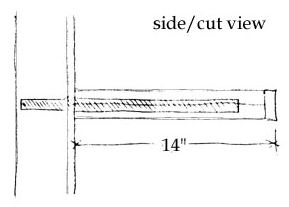Question
I am looking for a better door bottom seal that allows the installation of a double door flush bolt that does not interrupt the sealing qualities of the seal. It needs to be a blind install so the seal is not visible from either side of the door.
Forum Responses
(Architectural Woodworking Forum)
From contributor D:
We typically make our exterior doors at 2-1/4" thick. This allows for a rabbeted door bottom that can conceal the door bottom. Our normal is a bronze threshold with a brass hook on the door. This can nest into a 3/8" x 1-3/4" rabbet, so is concealed from the interior. In fact, there is a 1/8" gap to the wood sill trim, so the door has an even reveal on all sides on the interior. This is on inswing doors, of course.
The bronze interlock/hook can be set back far enough that the 2-1/4" doors allow for a centered extension bolt in the passive door to bypass the hook and lock into the bronze. The exterior will show the lower part - sometimes a full width bronze threshold, sometimes a 1-1/4" wide x 3/8" tall bronze interlock. There is no way to avoid this.
With adjustable commercial sills, a vinyl bulb is used. The aluminum track that holds the bulb is recessed into a plow into the bottom of the door and mostly concealed.
If you are using Endura or similar sills for paired units, there is no good solution beyond interior surface bolts. The Europeans have better solutions (sills), but the materials are hard to get here and often demand significant changes to the jambs and rabbets that my traditional market will not accept.
Another method that may work on 1 3/4 is to cut a small rabbet in the bottom outside face of the door and use a European tilt turn type gasket to butt up against the threshold. This would work without offsetting the bolt but is visible from the outside. On a 2 1/4 door the rabbit can be deeper and not noticeable. These gaskets are available from a few sources in the US.
We quit using all metal thresholds because of bad thermal conductivity. You can actually get ice growing inside in cold weather. We have had no problems with frost or freezing the gaskets with thermally broken or wood thresholds.
Modern, more insulated construction, insulated glass and the fact that homes are cooled and heated more changes the way doors and windows need to be constructed.
